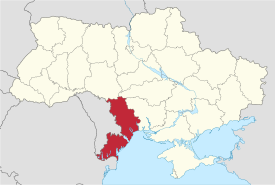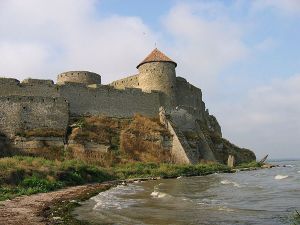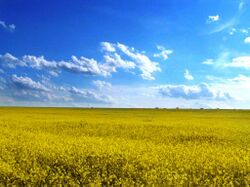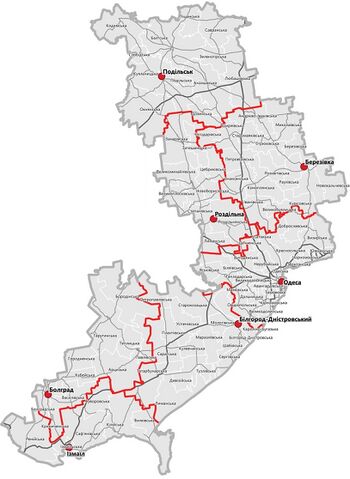أبلاست أوديسا
Odeska Oblast
Одеська область | |
|---|---|
| Odeska oblast[1] | |
 | |
| الإحداثيات: 47°00′N 30°00′E / 47.000°N 30.000°E | |
| Country | |
| Administrative center | Odessa |
| الحكومة | |
| • Governor | Serhiy Hrynevetsky[2] |
| • Oblast council | 84 seats |
| • Chairperson | Serhiy Paraschenko (Petro Poroshenko Bloc) |
| المساحة | |
| • الإجمالي | 33٬314 كم² (12٬863 ميل²) |
| ترتيب المساحة | Ranked 1st |
| التعداد (2021)[3] | |
| • الإجمالي | |
| • الترتيب | Ranked 6 |
| منطقة التوقيت | UTC+2 (EET) |
| • الصيف (التوقيت الصيفي) | UTC+3 (EEST) |
| Postal code | |
| Area code | +380-48 |
| ISO 3166 code | UA-51 |
| Raions | 26 |
| Cities (total) | 19 |
| • Regional cities | 7 |
| Urban-type settlements | 33 |
| Villages | 1138 |
| FIPS 10-4 | UP17 |
| الموقع الإلكتروني | www.oda.odessa.gov.ua |
Odessa Oblast (also known as Odesa oblast; أوكرانية: Оде́ська о́бласть, romanized: Odeska oblast; روسية: Одесская область, romanized: Odesskaya oblast; بالبلغارية: Одеска област; رومانية: Regiunea Odesa) is an oblast (province) of southwestern Ukraine, located along the northern coast of the Black Sea. Its administrative center is the city of Odesa (أوكرانية: Одеса, romanized: Odesa). Population: 2٬368٬107 (2021 est.)[3]
The region, the largest in Ukraine by area, is 33,314 km2, approximately the size of Belgium.[4] The length of coastline (sea-coast and estuaries) reaches 300 km (190 mi), while the state border stretches for 1،200 km (750 mi).[4] The region has eight seaports, over 80،000 ha (200،000 acre) of vineyards, and five of the biggest lakes in Ukraine.[4] One of the largest, Yalpuh Lake, is as large as the city of Odesa itself.[4]
التاريخ
Evidence of the earliest inhabitants in this area comes from the settlements and burial grounds of the Neolithic Gumelnița, Cucuteni-Trypillia and Usatove cultures, as well as from the tumuli and hoards of the Bronze Age Proto-Indo-Europeans. In the 1st millennium B.C. Milesian Greeks founded colonies along the northern coast of the Black Sea, including the towns of Olbia, Tyras, Niconium, Panticapaeum, and Chersonesus. The Greeks left behind painted vessels, ceramics, sculptures, inscriptions, arts and crafts that indicate the prosperity of their ancient civilisation.
The culture of Scythian tribes inhabiting the Black Sea littoral steppes in the first millennium B.C. has left artefacts in settlements and burial grounds, including weapons, bronze cauldrons, other utensils, and adornments. By the beginning of the 1st millennium A.D. the Sarmatians displaced the Scythians. In the 3rd–4th centuries A.D. a tribal alliance, represented by the items of Chernyakhov culture, developed. From the middle of the first millennium the formation of the Slavic people began. In the 9th century the eastern Slavs united into a state with Kyiv as its centre. The Khazars, Polovtsy and Pechenegs were the Slavs' neighbours during different times. Archeological evidence of the period of the 9th–14th centuries survives in materials from the settlements and cities of Kievan Rus': Belgorod, Caffa-Theodosia, and Berezan Island.
The Mongols took over the Black Sea littoral in the 13th century.
From about 1290 parts of the region were territories of the Republic of Genoa, becoming a center of Genoese commercial activity until at least the middle of the 14th century.[5]
The Grand Duchy of Lithuania acquired the area at the beginning of the 15th century.
In 1593 the Ottoman Empire set up in the area what became known as its Dnieper Province (Özü Eyalet), unofficially known as the Khanate of Ukraine.[6] Russian historiography refers to the area from 1791 as the Ochakov Oblast.[7] The territory of the Odesa Oblast passed to Russian control in 1791 in the course of the Russian southern expansion towards the Black Sea at the end of the 18th century.
After the February Revolution of 1917 in Russia the area became part of the Ukrainian People's Republic (1917–1918), but soon succumbed first to the Russian Volunteer Army (part of the White movement) and then to the Russian Bolshevik Red Army. By 1920 the Soviet authorities had secured the territory of Odesa Oblast, which became part of the Ukrainian SSR. The oblast was established on 27 February 1932 from five districts: Odesa Okruha, Pervomaisk Okruha, Kirovohrad Okruha, Mykolaiv Okruha, and Kherson Okruha.
In 1937 the Central Executive Committee of the USSR split off the eastern portions of the Odesa Oblast to form the Mykolaiv Oblast.[بحاجة لمصدر]
During World War II Axis forces conquered the area and Romania occupied the oblast and administered it as part of the Transnistria Governorate (1941–1944). After the war the Soviet administration reestablished the oblast with its pre-war borders.
Odesa Oblast expanded in 1954 to absorb Izmail Oblast (also known as the Budjak region of Bessarabia), formed in 1940 as a result of the Soviet occupation of Bessarabia and Northern Bukovina (from Romania), when Northern and Southern parts of Bessarabia were given to the Ukrainian SSR.
During the 1991 referendum, 85.38% of votes in Odesa Oblast favored the Declaration of Independence of Ukraine. A survey conducted in December 2014 by the Kyiv International Institute of Sociology found that 2.3% of the oblast's population supported their region joining Russia, 91.5% did not support the idea, and the rest were undecided or did not respond.[8] A poll reported by Alexei Navalny and conducted in September 2014 found similar results.[9]
On 4-5 July 2022 during international Ukraine Recovery Conference (URC 2022) in Lugano Switzerland pledged to support the rebuilding of Odesa region.[10]
الجغرافيا
Ukraine's largest oblast by area, the Odessa Oblast occupies an area of around 33،314 متر كيلومربع (12،863 sq mi). It is characterised by largely flat steppes - part of the Black Sea Lowland - divided by the estuary of the Dniester river. Its Black Sea coast has numerous sandy beaches, estuaries and lagoons. The region's soils (especially chernozems) have a reputation for fertility, and intensive agriculture is the mainstay of the local rural economy. The southwest has many orchards and vineyards, while arable crops grow throughout the region.
معالم
Economy
Significant branches of the oblast's economy are:
- oil refining and chemicals processing
- transportation (important sea and river ports, oil pipelines and railway);
- viticulture and other forms of agriculture, notably the growing of wheat, maize, barley, sunflowers and sugar beets.
The region's industrial capability is principally concentrated in and around Odesa.
السكان
The oblast's population (as at the start of 2021) was 2,368,107 people, nearly 43% of whom lived in the city of Odessa.
Significant Bulgarian (6.1%) and Romanian (5.0%) minorities reside in the province.[11] It has the highest proportion of Jews of any oblast in Ukraine (although smaller than the Autonomous City of Kiev) and there is a small Greek community in the city of Odessa.
Bulgarians and Romanians represent 21% and 13% respectively, of the population in the salient of Budjak, within Odessa Oblast.
| Year | Fertility | Birth |
|---|---|---|
| 1990 | 1,8 | 33 166 |
| 1991 | 1,7 | 32 119 |
| 1992 | 1,6 | 30 155 |
| 1993 | 1,5 | 28 185 |
| 1994 | 1,4 | 26 197 |
| 1995 | 1,4 | 24 993 |
| 1996 | 1,3 | 23 666 |
| 1997 | 1,2 | 22 491 |
| 1998 | 1,2 | 21 273 |
| 1999 | 1,1 | 19 969 |
| 2000 | 1,1 | 20 042 |
| 2001 | 1,1 | 20 423 |
| 2002 | 1,2 | 21 227 |
| 2003 | 1,2 | 22 326 |
| 2004 | 1,3 | 23 343 |
| 2005 | 1,3 | 23 915 |
| 2006 | 1,4 | 25 113 |
| 2007 | 1,5 | 26 759 |
| 2008 | 1,6 | 28 780 |
| 2009 | 1,6 | 28 986 |
| 2010 | 1,6 | 28 690 |
| 2011 | 1,6 | 29 225 |
| 2012 | 1,7 | 30 384 |
Age structure
- 0-14 years: 15.5% ▲ (male 188,937/female 179,536)
- 15-64 years: 70.7%
 (male 812,411/female 867,706)
(male 812,411/female 867,706) - 65 years and over: 14.0%
 (male 116,702/female 218,808) (2013 official)
(male 116,702/female 218,808) (2013 official)
Median age
- total: 38.4 years

- male: 35.4 years

- female: 41.5 years ▲ (2013 official)
الدين
Religion in Odessa Oblast (2015)[12]
The dominant religion in Odessa Oblast is Eastern Orthodox Christianity, professed by 84% of the population. Another 8% declares to be non-religious and 6% are unaffiliated generic Christians. Adherents of Catholicism and Protestantism make up 0.5% of the population respectively.
The Orthodox community of Odesa Oblast is divided as follows:
- Non-denominational - 46%
- Ukrainian Orthodox Church of the Moscow Patriarchate - 31%
- Ukrainian Orthodox Church of the Kyivan Patriarchate - 21%
- Ukrainian Autocephalous Orthodox Church - 1%
- غير معروف- 1%
التقسيمات الإدارية
Until 2020, the Odessa Oblast was administratively subdivided into 26 raions (districts) and 7 municipalities which were directly subordinate to the oblast government - (Bilhorod-Dnistrovskyi, Chornomorsk, Izmail, Podilsk, Teplodar, Yuzhne and the administrative center of the oblast, Odesa).
| Name | Ukrainian name | Area (km2) |
Population 2015[13] |
Admin.center | Urban Population Only*[13] |
|---|---|---|---|---|---|
| Odessa | Одеса (місто) | 139 | 1,010,490 | Odessa (city) | 1,010,490 |
| Bilhorod-Dnistrovskyi ^ | Білгород-Дністровський (місто) | 31 | 57,559 | Bilhorod-Dnistrovskyi (city) | 57,559 |
| Chornomorsk | Чорноморськ (місто) | 25 | 72,553 | Chornomorsk (city) | 67,323 |
| Izmail ^ | Ізмаї́л (місто) | 53 | 72,266 | Izmail (city) | 72,266 |
| Podilsk | Подільськ (місто) | 25 | 40,613 | Podilsk (city) | 40,613 |
| Teplodar | Теплодар (місто) | 3 | 10,277 | Teplodar (city) | 10,277 |
| Yuzhne | Южне (місто) | 9 | 32,149 | Yuzhne (city) | 32,149 |
| Ananiv Raion | Ананьївський (район) | 1,050 | 26,999 | Ananiv | 8,441 |
| Artsyz Raion ^ | Арцизький (район) | 1,379 | 45,274 | Artsyz | 14,886 |
| Balta Raion | Балтський (район) | 1,317 | 41,666 | Balta | 18,940 |
| Berezivka Raion | Березівський (район) | 1,637 | 33,930 | Berezivka | 12,614 |
| Bilhorod-Dnistrovskyi Raion ^ | Білгород-Дністровський (район) | 1,852 | 60,774 | Bilhorod-Dnistrovskyi (city) | N/A * |
| Bilyayivka Raion | Біляївський (район) | 1,497 | 94,083 | Biliaivka | 14,334 |
| Bolhrad Raion ^ | Болградський (район) | 1,364 | 69,148 | Bolhrad | 15,451 |
| Ivanivka Raion | Іванівський (район) | 1,162 | 26,604 | Ivanivka | 8,807 |
| Izmail Raion ^ | Ізмаїльський (район) | 1,194 | 51,584 | Izmail (city) | N/A * |
| Kiliya Raion ^ | Кілійський (район) | 1,358 | 52,400 | Kiliya | 28,434 |
| Kodyma Raion | Кодимський (район) | 818 | 29,586 | Kodyma | 11,195 |
| Lyman Raion | Комінтернівський (район) | 1,499 | 71,158 | Dobroslav | 14,028 |
| Liubashivka Raion | Любашівський (район) | 1,100 | 30,688 | Liubashivka | 10,954 |
| Mykolaivka Raion | Миколаївський (район) | 1,093 | 16,127 | Mykolaivka | 2,850 |
| Ovidiopol Raion | Овідіопольський (район) | 829 | 78,941 | Ovidiopol | 32,486 |
| Okny Raion | Окнянський (район) | 1,013 | 20,186 | Okny | 5,338 |
| Podilsk Raion | Подільський (район) | 1,037 | 27,091 | Podilsk (city) | N/A * |
| Reni Raion ^ | Ренійський (район) | 861 | 58,352 | Reni | 25,527 |
| Rozdilna Raion | Роздільнянський (район) | 1,368 | 37,353 | Rozdilna | 19,003 |
| Sarata Raion ^ | Саратський (район) | 1,474 | 45,057 | Sarata | 4,351 |
| Savran Raion | Савранський (район) | 617 | 19,083 | Savran | 6,420 |
| Shyriaieve Raion | Ширяївський (район) | 1,502 | 27,151 | Shyriaieve | 6,781 |
| Tarutyne Raion ^ | Тарутинський (район) | 1,874 | 41,603 | Tarutyne | 12,932 |
| Tatarbunary Raion ^ | Татарбунарський (район) | 1,748 | 38,825 | Tatarbunary | 10,988 |
| Velyka Mykhailivka Raion | Великомихайлівський (район) | 1,436 | 31,006 | Velyka Mykhailivka | 8,472 |
| Zakharivka Raion | Захарівський (район) | 956 | 20,233 | Zakharivka | 8,881 |
- Note: An asterisk (^) indicates the two municipalities and nine raions which previously constituted Izmail Oblast until that former oblast's merger with Odessa Oblast on 15 February 1954; these areas lie to the west of the Dniester River, and formerly constituted the territory known as the Budjak (southern Bessarabia). In the 18 July 2020 reorganisation, these nine raions were reduced to three, which also incorporated the two former independent cities.
- Note: Asterisks (*) Though the administrative center of the rayon is housed in the city/town that it is named after, cities do not answer to the rayon authorities only towns do; instead they are directly subordinated to the oblast government and therefore are not counted as part of rayon statistics.
On 18 July 2020, the number of districts (raions) was reduced to seven, now also incorporating the formerly independent cities.[14][15] (see map). They are now divided into 91 municipalities (hromadas).
| Name | Ukrainian name | Area (km2) |
Population 2001 Census[16] |
Admin.center | Population 2021 Estimate |
Number of hromadas |
|---|---|---|---|---|---|---|
| Berezivka Raion | Березівський (район) | 5,546 | 121,518 | Berezivka | 106,490 | 16 |
| Bilhorod-Dnistrovskyi Raion ^ | Білгород-Дністровський (район) | 5,177 | 214,211 | Bilhorod-Dnistrovskyi (city) | 198,682 | 16 |
| Bolhrad Raion ^ | Болградський (район) | 4,477 | 167,464 | Bolhrad | 146,424 | 10 |
| Izmail Raion ^ | Ізмаїльський (район) | 3,505 | 239,096 | Izmail (city) | 207,333 | 6 |
| Odessa Raion | Овідіопольський (район) | 3,946 | 1,353,314 | Ovidiopol | 1,382,541 | 22 |
| Podilsk Raion | Подільський (район) | 7,048 | 266,948 | Podilsk (city) | 224,163 | 12 |
| Rozdilna Raion | Роздільнянський (район) | 3,568 | 106,506 | Rozdilna | 102,584 | 9 |
Notable people
One of the most famous Odessits is Sergei Utochkin who was a universal sportsman excelling in cycling, boxing, swimming and played football for the Odessa British Athletic Club.[4] Utochkin had challenged a steam-powered tram while running, on a bicycle he beat a galloping horse, while on roller skates he was passing a bicyclist.[4] The next stage for him was to conquest skies.[4] Utochkin managed to buy an airplane from a local banker and completed dozens of exhibition flights.[4] Eventually, he managed to assemble his own Farman-type airplane.[4] In Kiev, Utochkin was demonstrating his piloting skills in front of some 50,000 people, among which was a future creator of helicopters Igor Sikorsky.[4]
A number of other notable people were born in Odessa, including the poet Anna Akhmatova, former NASA scientist Nicholas E. Golovin who worked with the Apollo program, as well as the founder of jazz in the Soviet Union Leonid Utyosov.[4]
انظر أيضاً
- Subdivisions of Ukraine
- Kherson Governorate
- Budjak
- Transnistria
- Gagauzia
- Bessarabia
- Moldova
- Romania
- Ukraine
- Black Sea
- USSR
References
- ^ Syvak, Nina; Ponomarenko, Valerii; Khodzinska, Olha; Lakeichuk, Iryna (2011). Veklych, Lesia (ed.). Toponymic Guidelines for Map and Other Editors for International Use (PDF). scientific consultant Iryna Rudenko; reviewed by Nataliia Kizilowa; translated by Olha Khodzinska. Kyiv: DerzhHeoKadastr and Kartographia. p. 20. ISBN 978-966-475-839-7. Retrieved 2020-10-06.
{{cite book}}:|website=ignored (help) - ^ (in أوكرانية) Zelensky appointed leaders of Kharkiv and Odesa regions, Ukrayinska Pravda (27 November 2020)
- ^ أ ب "Чисельність наявного населення України (التعداد الفعلي لأوكرانيا)" (PDF) (in الأوكرانية). مصلحة إحصائيات الدولة الأوكرانية. Retrieved 11 July 2021.
- ^ أ ب ت ث ج ح خ د ذ ر ز Tell about Ukraine. Odesa Oblast. 24 Kanal (youtube).
- ^ Browning, Robert (1991). "Asprokastron". In Kazhdan, Alexander (ed.). The Oxford Dictionary of Byzantium. Oxford and New York: Oxford University Press. p. 212. ISBN 978-0-19-504652-6.
- ^
Secrieru, Mihaela. "Republic of Moldavia – an Intermezzo on the Signing and the Ratification of the European Charter for Regional and Minority Languages" (PDF). Iași: "Alexandru Ioan Cuza" University of Iaşi. p. 2. Retrieved 2014-09-19.
On the left shore of the River Nistru [Dniester] there was the Khanate of Ukraine and of the properties of the Polish Crown, and their inhabitants, until the end of the 18th century, were the Moldavians[.]
- ^
Friesen, Leonard G. (2008). Rural Revolutions in Southern Ukraine: Peasants, Nobles, and Colonists, 1774–1905. Harvard series in Ukrainian studies. Vol. 59. Harvard University Press. p. 40. ISBN 9781932650006. Retrieved 2014-09-19.
[...] the war with the Ottoman Empire [...] ended with the Treaty of Eternal Peace in December 1791, whereby the so-called Ochakiv (Ochakov) oblast was brought into the empire.
- ^ Лише 3% українців хочуть приєднання їх області до Росії [Only 3% of Ukrainians want their region to become part of Russia]. Dzerkalo Tyzhnia (in الأوكرانية). 3 January 2015.
- ^ "Провідні країни Європи відбудовуватимуть Україну, – Гайдай". LB.ua. 5 July 2022. Retrieved 2022-07-11.
- ^ Results of the 2001 All-Ukrainian population census for the Odesa oblast
- ^ "Religious preferences of the population of Ukraine". Sociology poll by Razumkov Centre, SOCIS, Rating and KIIS about the religious situation in Ukraine (2015)
- ^ أ ب "Населення та міграція, Чисельність населення на 1 грудня 2015 року та середня за січень-листопад 2015 року" [Population and migration, Population as of December 1, 2015 and average for January-November 2015]. UkrStat (in الأوكرانية). Retrieved 7 January 2016.
- ^ "Про утворення та ліквідацію районів. Постанова Верховної Ради України № 807-ІХ". Голос України (in الأوكرانية). 2020-07-18. Retrieved 2020-10-03.
- ^ "Нові райони: карти + склад" (in Ukrainian). Міністерство розвитку громад та територій України.
{{cite web}}: CS1 maint: unrecognized language (link) - ^ State Statistics Committee of Ukraine (web).
وصلات خارجية
- Pages using gadget WikiMiniAtlas
- CS1 errors: periodical ignored
- Articles with أوكرانية-language sources (uk)
- CS1 الأوكرانية-language sources (uk)
- CS1 uses الأوكرانية-language script (uk)
- CS1 uses الروسية-language script (ru)
- CS1 الروسية-language sources (ru)
- Short description is different from Wikidata
- Coordinates on Wikidata
- Articles containing أوكرانية-language text
- Pages using Lang-xx templates
- Articles containing روسية-language text
- Articles containing بلغارية-language text
- Articles containing رومانية-language text
- Articles with unsourced statements from September 2015
- Articles with hatnote templates targeting a nonexistent page
- أبلاست أوديسا
- Bulgarian-speaking countries and territories
- Romanian-speaking countries and territories
- Russian-speaking countries and territories
- Ukrainian-speaking countries and territories
- أبلاستات أوكرانيا
- Bessarabia
- States and territories established in 1932
- 1932 establishments in Ukraine





